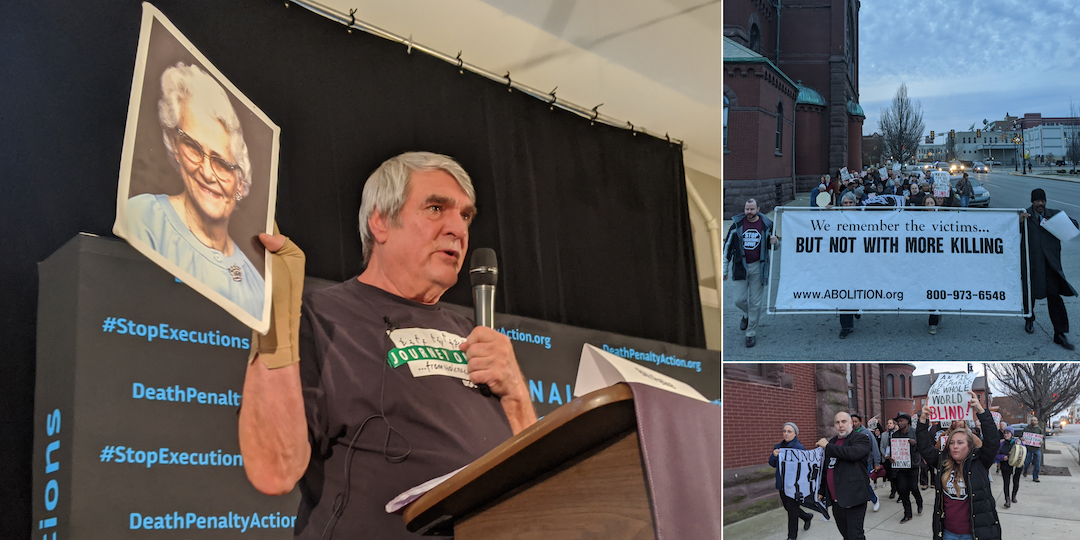Documentary Film and The “Blackfish” Effect

Films can have a huge effect on human culture. I call them weapons of mass construction. You drop a bomb and people get killed. You make a film and you create allies. And that’s the goal. That film is made to create a tipping point.
The art of documentary film has a long and distinguished track record of stirring the conscience and spurring people to action. Sundance Board of Trustees member Jacki Zehner explains, “Documentary films can educate, raise awareness, and inspire change like few other forms of media. In a world where visual media dominates and social media is the channel through which we communicate, there is no better tool for changing hearts and minds than the feature-length documentary film.” Not all documentaries are meant to have a social impact, but a wellmade social impact film’s potential for challenging stories that have been in place and widely accepted for generations is well known, and examples are legion. Think Harlan County, USA, the films of Frederick Wiseman, Michael Moore’s exposés, An Inconvenient Truth, and Super Size Me, each of which created new narratives for the public to consider and act upon.
Narrative shift often takes years, even decades, to happen, but a broadly distributed, hard-hitting documentary film that delivers a strong emotional punch can change the story in a relatively short period. This case study shows how, under certain circumstances, even a very modestly financed documentary film can have a long-lasting, huge, long-term narrative impact. Before 2013, only the most committed animal rights activists gave much thought to the plight of oceanic mammals kept in captivity by SeaWorld, one of the country’s largest entertainment companies. After 2013 and the airing of the documentary Blackfish on CNN, a new and compelling narrative took hold that challenged SeaWorld’s claim that the animals were treated humanely, and the public’s response forced the company to change its practices. This shift was so dramatic that reporters covering business affairs gave it a name: the “Blackfish effect.”
The ‘Blackfish effect’ has become common parlance—used to describe the disastrous impact of a revelatory piece of popular culture on a stalwart business—and has been studied in a number of fields, from the entertainment industry to psychology.[1]
METHODOLOGY
INTERVIEWS:
- Louie Psihoyos, Academy Award-winning documentary filmmaker and executive director of the Oceanic Preservation Society
OTHER SOURCES CONSULTED:
- Doc Society, Winner: Blackfish, an Impact Field Guide
- Stefani Duhon, Kelli Ellison, and Matthew W. Ragas. (2016). A whale of a problem: A strategic communication analysis of SeaWorld Entertainment’s multi-year Blackfish crisis. Case Studies in Strategic Communication, 5, article 2.
- Caty Borum Chattoo and Lauren Feldman (2020). A Comedian and An Activist Walk Into A Bar: The Serious Role of Comedy in Social Justice. Oakland, CA: University of California Press; and Caty Borum Chattoo (2020). Story Movements: How Documentaries Empower People and Inspire Social Change. New York, NY: Oxford University Press.
BACKGROUND
In his “Dear Shareholder” letter in SeaWorld Entertainment’s 2013 Annual Report, CEO Jim Atchison wrote, “It has been a remarkable year.” He cited the success of the corporation’s Initial Public Offering in April of that year and reported that 2013 had ended with “record revenue of $1.46 billion, a 3 percent year-over-year increase.” He also projected that in 2014 revenue would grow still more and in signing off wrote, “I hope you are as gratified by our inaugural year performance as a public company as I am.” Yet that same year, a very different, parallel story was unfolding about SeaWorld that would dramatically undermine Atchison’s rosy predictions and would, in fact, lead some to believe that SeaWorld, long one of the most popular theme parks in the United States, might not survive.
SeaWorld Entertainment is a multi-billion dollar public corporation that operates three SeaWorld parks in California, Texas, and Florida.[2] Over the more than 50 years since its founding, the company has striven to brand itself not only as a place for families to enjoy rides, shows, and animal habitats, but also as “a global leader in animal welfare, training, husbandry and veterinary care.” In the words of SeaWorld, “Through our theme parks’ up-close animal encounters, educational exhibits and innovative entertainment, we strive to inspire each guest who visits one of our parks to care for and conserve the natural world.”
For decades, one of SeaWorld’s most popular shows, if not the most popular show, was “Shamu,” featuring the performance of an orca (killer whale) with an animal trainer. To the delight of the multi-generational viewers seated stadium-style around a huge tank, the trainer would jump into the water and join the whale in a series of choreographed movements. SeaWorld maintained that although kept in captivity, the orcas were treated humanely and the trainers who interacted with them were safe.
For years, animal welfare activist groups such as People for the Ethical Treatment of Animals (PETA) had been critical of SeaWorld for its treatment of the highly intelligent orcas, arguing that their captivity adversely affected their well-being and health. In 2011 PETA filed a suit in federal court seeking to apply the Thirteenth Amendment to “nonhuman animals.” The lawsuit claimed that five wild-captured orcas had been taken from their natural habitats and forced to perform at SeaWorld as “slaves.” The suit was dismissed in 2012 on the grounds the Thirteenth Amendment applied only to persons, not non-persons, and, although it generated some publicity, it didn’t have a noticeable effect on the SeaWorld brand. In early 2013, SeaWorld’s positive public sentiment, as measured by its “impression” rating, was still high.[3] The theme park was widely viewed as a family-friendly entertainment venue that treated both its employees and the animals under its care well.

ENTER BLACKFISH – THE FILM
In 2010, documentary filmmaker Gabriela Cowperthwaite came across an article on Outsideonline.com that piqued her curiousity. In a 9,000-word piece entitled “The Killer in the Pool,”[4] correspondent Tim Zimmermann described in great detail the recent death of SeaWorld trainer Dawn Brancheau, who was killed during a Shamu show by Tilikum, a 12,000 pound orca. After describing the gruesome event, Zimmermann reviewed the history of orca captivity in the United States, earlier orca attacks on other SeaWorld trainers, and the research findings of marine biologists. The director of British Columbia’s OrcaLab, which studies killer whales in the wild, said, “If you pen killer whales in a small steel tank, you are imposing an extreme level of sensory deprivation on them. Humans who are subjected to those same conditions become mentally disturbed.”
Cowperthwaite, who had made documentaries for television for 12 years, says she was haunted by the death of Brancheau, a 40-year-old, very experienced trainer. “I couldn’t understand why an intelligent, sentient animal would bite the hand that feeds it. This was a strange story, and I couldn’t shake it.” She found some funding, recruited producers and cinematographers, and spent the next 2 years making the film, which she titled Blackfish, the Inuit name for the orca.
The film challenged the SeaWorld narrative on multiple levels. Former trainers spoke on camera about the lack of training and the fact that they had been kept ignorant of previous incidents of trainer injuries and deaths. They also spoke of SeaWorld’s practice of separating young calves from their mothers and the obvious and extreme anguish this caused to both. Scientists described the complex social relationships among orcas in the wild and the fact that they are highly intelligent and use language to communicate within their families and with other pods. The film made a strong case against keeping these highly social animals in captivity, demonstrating that putting them in confined environments and altering their family structures is harmful to the orcas and can lead to aggressive and even deadly behavior.
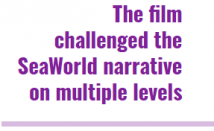 On January 19, 2013, Blackfish premiered at the Sundance Film Festival and in July it was released in theaters. Variety described it as a “mesmerizing psychological thriller with a bruised and battered killer whale at its center….Righteous, captivating and entirely successful.” If that had been the extent of its distribution, in all likelihood the film would not have caused much of a stir in spite of its rave review. But the Sundance premiere had created enough of a buzz for CNN to secure rights to air it, and on October 24, 2013, it premiered on CNN and was seen by more than 24 million viewers in the United States and Europe. Two weeks later, CNN aired an encore broadcast, and soon thereafter the film was released on Blu-Ray and DVD. The public response was extraordinary; the film had struck a chord:
On January 19, 2013, Blackfish premiered at the Sundance Film Festival and in July it was released in theaters. Variety described it as a “mesmerizing psychological thriller with a bruised and battered killer whale at its center….Righteous, captivating and entirely successful.” If that had been the extent of its distribution, in all likelihood the film would not have caused much of a stir in spite of its rave review. But the Sundance premiere had created enough of a buzz for CNN to secure rights to air it, and on October 24, 2013, it premiered on CNN and was seen by more than 24 million viewers in the United States and Europe. Two weeks later, CNN aired an encore broadcast, and soon thereafter the film was released on Blu-Ray and DVD. The public response was extraordinary; the film had struck a chord:
- It was ranked number 1 in the 25–54 demographic in cable news.
- The online trailer had 1,065,019 views.
- The day after the first CNN broadcast, Google searches for the term “blackfish” soared.
- Twitter said it was the most talked about show on CNN in October 2013 with 67,673 tweets seen by 7.3 million people.
- It was shown at close to 30 national and international film festivals.
- It was shortlisted for the Best Documentary Feature at the 2014 Academy Awards.
- It began streaming on Netflix in December 2013 and 2 years later it was still one of the 10 highest rated science and nature documentaries among U.S. Netflix users.
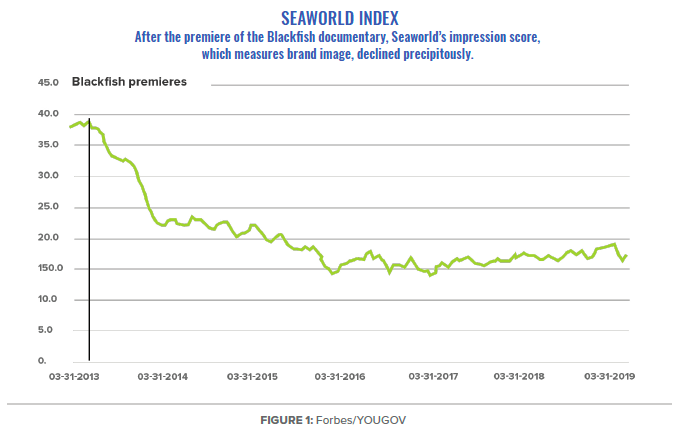
THE IMPACT CAMPAIGN
Cowperthwaite and her partners had not set out to launch a campaign with their film. Their more modest goal was to elevate an issue that up until then had been unrecognized by the broader public. But the CNN broadcasts created an enormous buzz, and celebrities, corporations, and the public at large took action. The social media response to Blackfish was extraordinary, and that generated traditional media coverage as well. According to a strategic communications analysis by scholars at DePaul University, once CNN secured broadcast rights it began to brainstorm ways to leverage the growth of the conversation on Twitter as the show’s premiere approached. CNN invited users to join in on the conversation using #Blackfish.
According to Twitter, there were 67,673 tweets about Blackfish seen by 7.3 million people the night the film aired, making it the most talked about show on CNN that month. Anderson Cooper hosted a live post-show debate that expanded the conversation on traditional and social media, and additional celebrities including Ariana Grande, Zach Braff, Michelle Rodriguez, and Stephen Fry chimed in and encouraged their followers to watch the documentary and think twice before visiting a SeaWorld park. In December, eight out of 10 scheduled musical acts pulled out of SeaWorld Orlando’s Bands, Brew and BBQ concert series citing Blackfish as the reason. One of the performers was Willie Nelson, who was responding to a petition launched by Change.org, which garnered close to 10,000 signatures. That same month Joan Jett asked SeaWorld to stop using her song “I Love Rock ‘n’ Roll” during the Shamu Rocks opening number.
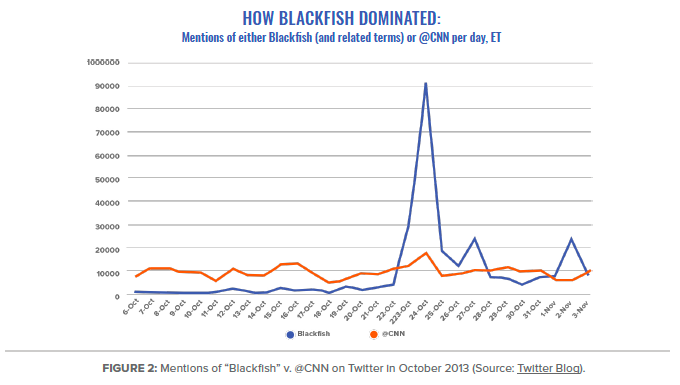
Throughout the distribution of the film, advocacy organizations including PETA, the Humane Society, Born Free Foundation, Voice of the Orcas, and Oceanic Preservation Society used the film for their own campaigns, helping to promote Blackfish. PETA members jumped in front of SeaWorld’s float in protest at the 2014 Rose Parade—a scene broadcast by CNN and other national news outlets. The group also installed a large poster at San Diego International Airport in 2015, urging the 130,000 people attending the annual ComicCon gathering in San Diego to boycott SeaWorld. When Macy’s annual Thanksgiving Day Parade announced that SeaWorld would be sponsoring a float, “A Sea of Surprises,” PETA called for the float to be banned, publicly protesting outside the department store in New York and launching an email campaign that generated 78,000 messages to Macy’s CEO. The float went ahead, and protestors shouted “Boycott SeaWorld” and handed out leaflets.
SeaWorld’s response to the campaign was defensive. It posted a detailed critique of the documentary on its website soon after the Sundance premiere in which it charged that the film was misleading and the trainers interviewed were not credible. Prior to the CNN broadcast the company released a statement claiming that “the film paints a distorted picture that withholds from viewers key facts about SeaWorld and fails to mention SeaWorld’s commitment to the safety of its team members and guests and to the care and welfare of its animals.” In December 2013, as the furor grew, SeaWorld published an open letter in major newspapers defending its treatment of killer whales. But this PR effort only succeeded in generating more media coverage and creating more, not less, controversy. In a New York Times article, entertainment correspondent Michael Cieply wrote: “The exchange is now promising to test just how far business can, or should, go in trying to disrupt the powerful negative imagery that comes with the rollout of documentary exposés.” On March 23, 2014 USA Today first described the “Blackfish effect.” The business community took note.
Corporations associated with SeaWorld began to feel the heat and some took action. In May 2014 Taco Bell came under fire by PETA for offering discounted tickets to SeaWorld and ended up cutting its ties with the company. In July of that year, Southwest Airlines and SeaWorld announced the end of a promotional marketing relationship that had dated back to 1988. In October 2014 Virgin America ended its association with SeaWorld, dropping it from its airline reward program.
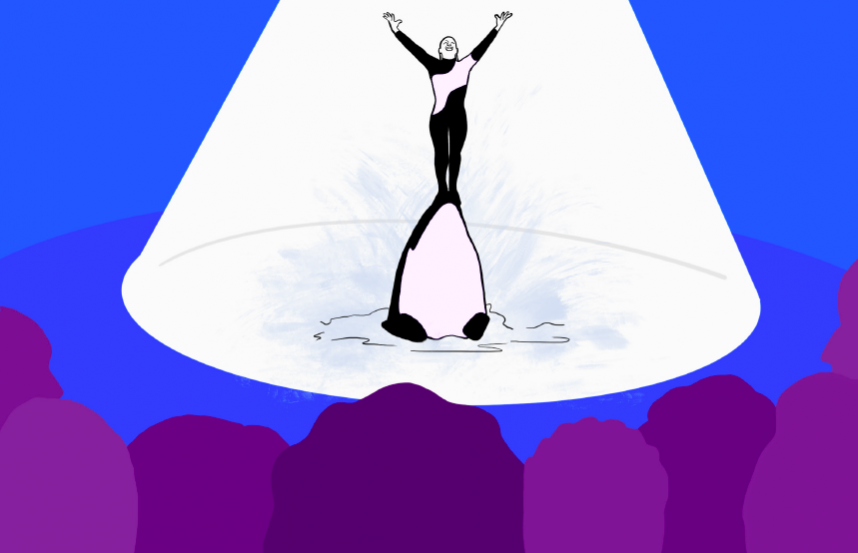
THE NUMBERS
By the end of 2014 it was clear that the Blackfish effect had had a significant impact on SeaWorld’s profitability. Headlines in early 2015 emphasized its losses, and all the articles attributed those losses to the impact of the documentary. A sampling includes:
- “SeaWorld sees major drop in attendance at US theme parks,” San Antonio Business Journal, Feb 26, 2015
- “SeaWorld posts wider 4Q loss as theme park attendance falls,” The Associated Press State & Local Wire Feb 26, 2015
- “The Blackfish effect: SeaWorld loses $25.4 million after documentary criticizing treatment of killer whales cuts park attendance,” Associated Press, Feb. 27, 2015
- “SeaWorld attendance, revenue, net income sink in 2014,” Orlando Business Journal, Feb 26, 2015

One million fewer people visited SeaWorld theme parks in 2014 than in 2013, and the drop in attendance lowered annual revenues by more than $82 million. That year the company’s stock price underperformed, its shares declining 38 percent. Business journalist W. Scott Bailey wrote: “The declines come as SeaWorld continues to deal with a public backlash stemming from the 2013 release of Blackfish, a documentary capturing the death of one of its trainers.” In January 2014 Jim Atcheson, the theme park’s CEO and president since 2009, resigned. On March 17, 2016 SeaWorld Entertainment announced that it would begin to phase out its orca shows and halt its breeding program, essentially making the living whales in its care its last. In a prepared statement, CEO Joel Manby explained:
As society’s understanding of orcas continues to change, SeaWorld is changing with it. By making this the last generation of orcas in our care and re-imagining how guests will encounter these beautiful animals, we are fulfilling our mission of providing visitors to our parks with experiences that matter.
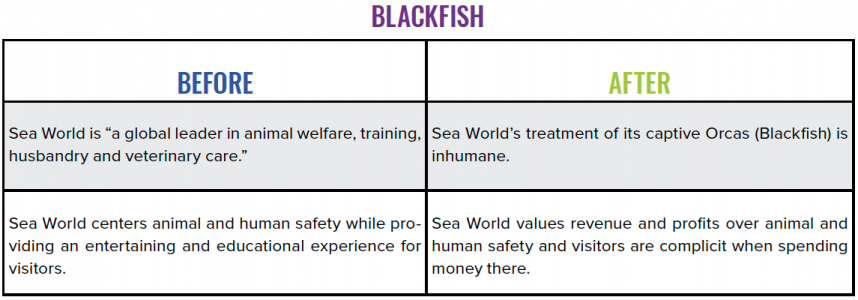
CONCLUSION
The Blackfish experience is a blueprint for how even a very modestly financed documentary film can have a huge narrative impact. Caty Borum Chattoo, executive director of the Center for Media & Social Impact at the American University School of Communication and author of two books about the role of media and narrative in social change, writes[5] in her new book, Story Movements: How Documentaries Empower People and Inspire Social Change, that the impact of Blackfish can be attributed to five elements:
- Narrative Persuasion and the Role of Emotion. Narrative persuasion is a well-developed body of research with insights about how stories impact audiences. According to the theory of narrative transportation, when audiences are deeply immersed in the story they can be absorbed into the story world, even forgetting their surroundings. Blackfish was a devastatingly emotional story that focused on a lead subject, Tilikum, who was brought to life almost as a human character, sparking public fury amplified by news media narratives and a vocal group of activists.
- Amplified Community: Online and Offline Grassroots Activism. The film was not released into a cultural vacuum. It fell into a prime spot with social change infrastructure ready to leverage a strategic distribution strategy and well-produced documentary story. With audiences fired up and ready to act, professional animal rights groups captured the momentum and provided the public with ways to take action, raise their voices, and directly pressure SeaWorld.
- Cultivated Media Narrative. Media coverage over the course of the three core Blackfish effect years was distinct. It evolved away from traditional film reviews and much deeper into the drama-filled story and ensuing activism and SeaWorld’s response, which generated enticing angles with new news value.
- Strategic Layered Distribution. Layered distribution across platforms over a period of time is essential for social change fueled by documentaries. Each distribution tier for Blackfish stoked public and media interest, and each display outlet, from the Sundance Film Festival to theatrical screenings to the CNN premiere to Netflix streaming, was meaningful.
- Public Call to Action Embedded in the Story. Blackfish did not simply raise awareness about captive orcas; it incited the public to take some form of action, like calling for a SeaWorld boycott, live tweeting during the CNN broadcast, and engaging in physical protest even though the filmmakers themselves did not explicitly call for it. The audience understood SeaWorld’s role, and the film’s narrative about orcas in captivity issued a clarion call. The public was moved and motivated to make noise and call for change, and it did, over and over.
On March 17, 2016 the Los Angeles Times published an op-ed by Joel Manby, president and CEO of SeaWorld Parks and Entertainment. In “The last SeaWorld orcas,” Manby announced the end of all orca breeding programs and the phasing out of its Shamu shows. He also rededicated the company to the preservation of marine wildlife. It is telling that the piece begins with this sentence: “Americans’ attitudes about orcas have changed dramatically.” The documentary film Blackfish can take credit for bringing about the narrative shift that “inspired the changing attitudes that, in turn, inspired our company’s changing policies.”
1 James Cromwell, “Park’s violent response can’t be justified,” San Diego Union Tribune, September 28, 2017.
2 SeaWorld Entertainment is comprised of 11 theme parks including three SeaWorlds. Other parks are Busch Gardens, Aquatica, Discovery Cove, Adventure Island, Water Country USA, and Sesame Place.
3 “Impression” scores measure brand image: Which of the following brands do you have a generally POSITIVE/NEGATIVE feeling about?
4 https://www.outsideonline.com/1924946/killer-pool
5 Caty Borum Chattoo, Story Movements: How Documentaries Empower People and Inspire Social Change, 2020.





